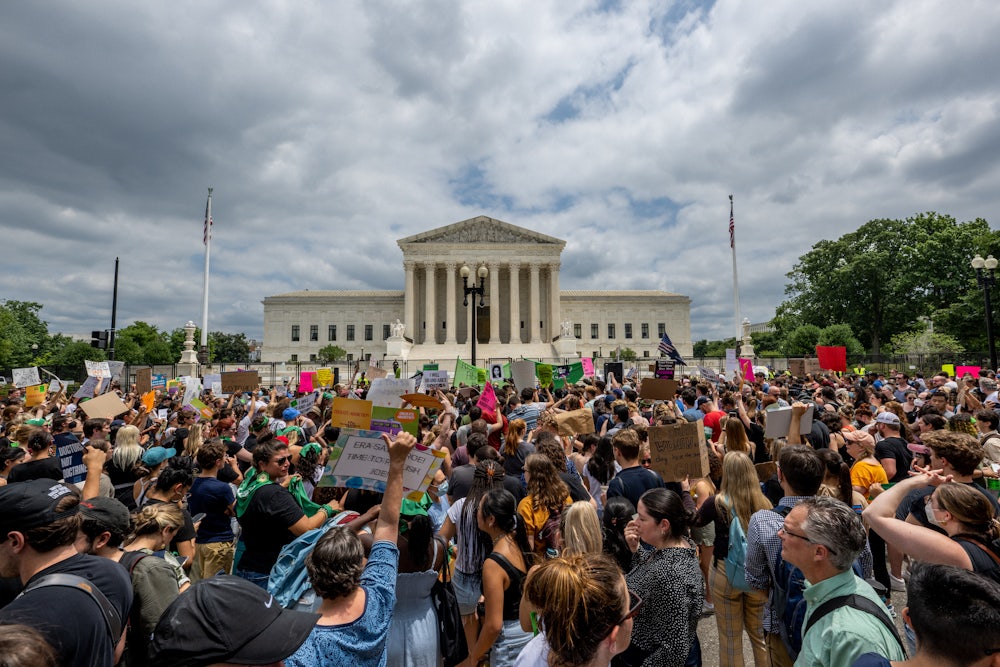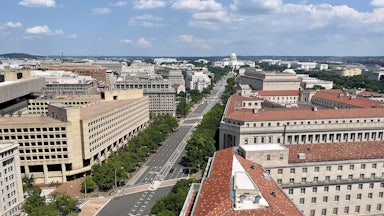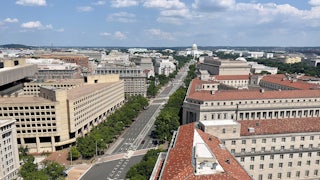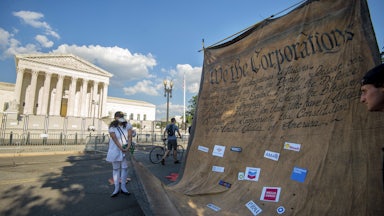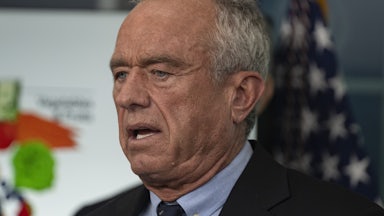Who gets to govern the United States? The Constitution begins with the immortal words “We the People,” but the reality is more complicated than that. We the people have jobs and mortgages and families to worry about. So the American people delegate that responsibility to our elected officials. They, in turn, hire and fire the people who test our drinking water for pollutants, evaluate the safety of new drugs, protect our coasts from overfishing, and much more. If Americans are unsatisfied with the way their public servants are managing their assigned affairs, they can hire and fire those elected officials every few years.
The Supreme Court’s upcoming term threatens to upend that democratic system’s basic contours—and make it harder for we, the people, to live our lives. The six conservative justices on the court aren’t threatening to abolish Congress or seize control of the White House, of course. But their rulings in a handful of upcoming cases this term could subordinate the two elected branches of government to the judiciary for the benefit of wealthy Americans and corporate special interests—and to the detriment of everyone else.
On Tuesday, the justices will hear oral arguments in Consumer Financial Protection Bureau v. Community Financial Services Association of America. The case is a challenge to the funding mechanism that Congress set up for the CFPB when it created the consumer-finance watchdog agency as part of the Dodd-Frank financial reforms in 2011. Unlike some other federal agencies that receive annual appropriations from lawmakers, Congress allows the CFPB to draw its funding directly from an account in the Federal Reserve System.
The CFPB published a rule in 2017 that limited the number of automated withdrawal requests that lenders could make to their customers’ bank accounts, which the agency concluded could harm lower-income customers by overdrafting their bank accounts or even forcing their closure before they could make the payments. A trade association for payday lenders sued the agency to block the rule by arguing, among other things, that the CFPB’s rulemaking process was unconstitutional because its funding structure violated the Constitution’s appropriations clause.
While many agencies are funded by annual appropriations from Congress, some are not. Some early agencies, like the Post Office and the Patent Office, funded their budgets by fees levied on customers and applicants. That practice persists into the present day: The Federal Deposit Insurance Corporation, for example, is funded entirely by deposit insurance premiums paid by banks. Some other financial regulators like the Federal Reserve Board of Governors are funded through a similar standing appropriation from other sources. Taken altogether, Congress has allowed federal agencies to receive funding from a variety of different sources, and it retains the power to change those arrangements whenever it sees fit.
The Fifth Circuit Court of Appeals disagreed. Judge Cory Wilson, writing for a unanimous three-judge panel, described the funding mechanism as a violation of the appropriations clause as well as a blow to the separation of powers. “Even among self-funded agencies, the Bureau is unique,” he claimed, quoting from precedent. “The Bureau’s perpetual self-directed, double-insulated funding structure goes a significant step further than that enjoyed by the other agencies on offer. And none of the agencies cited above ‘wields enforcement or regulatory authority remotely comparable to the authority the [Bureau] may exercise throughout the economy.’”
Wilson’s opinion echoed the widespread belief in the conservative legal movement that the CFPB is a dangerous threat to liberty and must be either reined in or destroyed. The Supreme Court’s conservative majority, which appears similarly skeptical of the consumer-finance watchdog, previously dismantled the statutory for-cause protections for the CFPB’s director in 2018. In one notable exchange on Capitol Hill, a Republican lawmaker from Pennsylvania told CFPB Director Rohit Chopra during a congressional hearing earlier this year that the financial industry was not happy with the agency’s work and urged her to “be responsive to the clientele that you’re supposed to be helping” when adopting new policies and regulations.
“Just to be clear, the clientele of the CFPB is not banks,” Chopra responded. “The clientele is the public.”
If the Supreme Court rules against the CFPB, it could ultimately strike down the entire agency as unconstitutional, imperiling a decade of financial regulations and spreading chaos in American credit markets. With that in mind, a friend of the court brief by national credit union organizations urged the justices to stay any adverse ruling against the CFPB for four months so that Congress could adopt a new funding structure for the agency in the interim. “While the Bureau’s entrenchment in everyday financial life cannot save its unconstitutional structure, nor should it influence the Court’s severance analysis, eliminating the agency from the regulatory ecosystem overnight would be dangerous and create uncertainty,” the groups told the court.
It is very strange to urge the justices to strike down an agency as unconstitutional and also urge them to let the agency survive a little longer so the American economy does not partially collapse. One can’t help but think of the proverbial patient who says his neck hurts when he moves it in a weird position and the proverbial doctor who replies, “Then stop moving it like that.” Since Congress can’t bring itself to fund the rest of the federal government at the moment, it would be strange to have any hope that a divided Congress will appropriate funds for an agency that Republicans and their donors loathe.
The ultimate outcome of the ruling, however, would be to second-guess Congress’s heretofore broad authority on how federal agencies can be funded. Narrowing the appropriations clause in this manner would mean that the Supreme Court, not Congress, would ultimately decide how federal agencies must be structured and funded. Congress’s goal with the CFPB’s current funding mechanism was to insulate the agency’s financial regulatory powers from day-to-day politics, and the court’s ruling would have the opposite effect, allowing lawmakers who are allied with the financial services sector greater influence over its operations during the appropriations process.
The road to this state of affairs began in the summer of 1971 when Lewis Powell wrote a memorandum for the U.S. Chamber of Commerce. Powell was a soft-spoken corporate lawyer from Virginia who had represented tobacco companies and other business interests in private practice. He was asked by a close friend who worked for the Chamber to outline a major strategy for American business leaders: how to recapture major American institutions and defeat their liberal and left-wing critics.
“No thoughtful person can question that the American economic system is under broad attack,” Powell began, alternatively defining that system as the “free enterprise system,” the “profit system,” or simply “capitalism” in a footnote. He noted that this system had been challenged before either by well-intentioned critics or fringe ideologues, none of whom had threatened its fundamental workings. What he saw that summer, however, was “quite new in the history of America,” Powell opined. “The assault on the enterprise system is broadly based and consistently pursued. It is gaining momentum and converts.”
He described Ralph Nader, a consumer advocate who had just published a book criticizing the U.S. auto industry for releasing unsafe vehicles to maximize profit, as “perhaps the single most effective antagonist of American business.” When a Washington Post columnist described certain tax policy changes as “only for the rich, the owners of big companies,” Powell saw something darker at work. “This setting of the ‘rich’ against the ‘poor,’ of business against the people, is the cheapest and most dangerous kind of politics,” he lamented.
What was to be done? To push back against this tide, Powell recommended that the Chamber—and the American business interests it represented—shake itself free from “apathy and default.” It must work, he argued, to retake college campuses from the left by demanding “balance” in textbooks, faculties, and speakers. Television networks and newspapers should be “kept under constant surveillance,” he wrote, so that complaints can be made about “unfair or inaccurate reporting.” High-quality articles should be constantly submitted to scholarly journals and prominent national magazines. Lobbyists should redouble their efforts to sway politicians in the “neglected political arena.”
Perhaps the most salient portion came when Powell discussed the “neglected opportunity” in the courts. “American business and the enterprise system have been affected as much by the courts as the executive and legislative branches of government,” he wrote. “Under our constitutional system, especially with the activist-minded Supreme Court, the judiciary may be the most important instrument for social, economic, and political change.”
Powell pointed to the success of liberal and left-wing groups in influencing the courts’ decision-making process, most often by filing friend of the court briefs, known as amicus briefs. These filings allow uninvolved third parties to advise judges and courts of the broader implications of a potential legal ruling. “Labor unions, civil rights groups, and now the public interest law firms are extremely active in the judicial arena,” he noted. “Their success, often at business’ expense, has not been inconsequential.”
To combat them, Powell urged business leaders to mount their own campaigns to persuade and influence the courts. “This is a vast area of opportunity for the Chamber, if it is willing to undertake the role as spokesman for American business and if, in turn, business is willing to provide the funds,” he concluded. Two months later, Richard Nixon nominated Powell to a vacant seat on the Supreme Court, where he served as an associate justice for the next 15 years.
Powell’s memo was initially meant only for internal consumption. It was published in full by the Chamber of Commerce only after excerpts of it had leaked to newspapers, well after Powell had already been confirmed to the high court. It would also be easy to overstate its historical significance: Conservative groups had already begun to mobilize in the late 1960s, as shown by Nixon’s own election three years earlier. The nascent conservative legal movement had also already formed in reaction to the Warren court’s sweeping changes of American society over the previous decade and a half.
At the same time, the memo was a key text in the rise of the American conservative moment as it exists today. It outlined a strategy that right-wing groups have used with extraordinary success over the last half-century. And it may pay off with extraordinary dividends at the Supreme Court’s term this fall, where the conservative majority is poised to fundamentally reshape how the United States is governed.
Meanwhile, a second case could give the federal courts—and, by extension, the Supreme Court—far greater influence over how agencies draft and revise new regulations. Loper Bright Enterprises v. Raimondo involves a challenge to a fishery-management rule for Atlantic herring. The rule required fishing boats to host observers at the industry’s expense to monitor the herring population. While the observers aren’t unusual, Loper Bright challenged the legality of requiring the industry to pay for them.
The lower courts dismissed the company’s challenge by invoking the Chevron doctrine. That doctrine, which dates back to a 1984 case involving the oil company, instructs courts to defer to an agency’s interpretation of a statute if it is based on a “permissible construction” of that statute. If the statute explicitly says an agency can do something or can’t do something, then the answer is fairly clear. If a statute is “silent or ambiguous” on something, then the agency gets some leeway to act.
The Chevron doctrine is a central feature of modern administrative law. Its defenders have justified it as a necessary act of judicial humility: If there are disputes about an agency’s power to do something, the Chevron doctrine means they will be resolved by the democratic process, through Congress’s power to write and amend statutes and a president’s power to order the agency to do something different. Among the more notable voices in favor of this approach was Justice Antonin Scalia, who described Chevron as a preferable alternative to judicial adventurism.
“To tell the truth, the quest for the ‘genuine’ legislative intent is probably a wild-goose chase anyway,” Scalia said in a 1989 lecture. “In the vast majority of cases I expect that Congress neither (1) intended a single result, nor (2) meant to confer discretion upon the agency, but rather (3) didn’t think about the matter at all. If I am correct in that, then any rule adopted in this field represents merely a fictional, presumed intent, and operates principally as a background rule of law against which Congress can legislate.”
Scalia stood somewhat alone among his conservative colleagues, however. Today, the conservative legal movement is almost uniformly opposed to the Chevron doctrine. Scalia and the doctrine’s opponents started from the same basis—that the doctrine is a core feature of what they call “the administrative state”—but where Scalia saw a pragmatic deference to the elected branches, others have seen an obstacle standing in the way of American businesses. Most of the court’s conservative justices have criticized Chevron in some way, including Clarence Thomas, who drifted away from it while developing closer personal relationships with right-wing billionaires. (This could just be a coincidence, of course.)
Thus many of the groups arguing in favor of nixing Chevron did so not only for legal and constitutional reasons but because it would benefit corporate interests. “Keeping each branch of government in its proper sphere of authority will preserve freedom and enable American industry to operate in a clear and predictable regulatory environment,” the U.S. Chamber of Commerce argued in its friend of the court brief. In its telling, Chevron is not a humble policy deference to the elected branches but a malevolent usurpation by devious federal agencies against a hapless Congress and a weak-willed judiciary.
Some have attempted to crowbar even more bespoke grievances about federal regulations into their arguments in Loper Bright. A group representing “electronic nicotine delivery system industry stakeholders”—the e-cigarette and vaping industry, in other words—complained that the Food and Drug Administration had used Chevron deference to ban flavored non-tobacco versions of their products. Even the Little Sisters of the Poor, a Catholic order of nuns that successfully fought the Affordable Care Act’s contraceptive mandate, chimed in. “Like the contraceptive mandate, the history of the transgender mandate amply demonstrates the negative impact of unchecked federal regulators on religious exercise,” the order told the justices in a friend of the court brief.
But the most noteworthy filing in Loper Bright isn’t from the parties themselves, but from a friend of the court brief filed on behalf of four Democratic senators. Senators Sheldon Whitehouse, Mazie Hirono, Dianne Feinstein, and Elizabeth Warren have been some of the most frequent critics of the conservative legal movement, its wealthy benefactors, and its influence on the high court. They argued that the case was not a genuine legal dispute but, rather, “the product of a decades-long effort by pro-corporate interests to eviscerate the federal government’s regulatory apparatus, to the detriment of the American people.”
“Special interests strategically file lawsuits challenging administrative rules and regulations, with coordinated mass filings of amicus curiae briefs, to convince courts to chip away at administrative agencies’ regulatory authority,” the senators argued. “Corporate interests funnel billions of dollars into think tanks, advocacy organizations, political elections, and judicial confirmations. They generate false information, ingratiate themselves with elected officials, and steer jurisprudence toward their deregulation goals.” In an unusual move, the senators also directly called out the other groups briefing the court for their conflicts of interest:
The common thread through these anti-regulatory positions is massive funding from pro-corporate special interests. The fossil fuel industry particularly has long sought to undermine executive regulatory authority. For example, amici The Buckeye Institute, Cato Institute, Competitive Enterprise Institute, Landmark Legal Foundation, Mountain States Legal Foundation, National Right to Work Legal Defense Foundation, New Civil Liberties Alliance, and Pacific Legal Foundation have all received hundreds of thousands, and sometimes millions, of dollars from Donors Trust and Donors Capital Fund—two donor-advised funds that allow ultra-wealthy interests to direct funding anonymously. Donors Trust—described as the “dark-money ATM of the right”—and Donors Capital Fund have for instance contributed over a third of a trillion dollars to fund the climate denial operation.
Indeed, some of those groups’ donors likely also spent millions in judicial-confirmation battles for the justices during the Trump years to engineer the conservative supermajority on the high court. To describe this interplay between power, political muscle, and donor capital as an “open secret” would be an understatement. “There is a coherent plan here, where actually the judicial selection and the deregulatory effort are really the flip side of the same coin,” Don McGahn, who led the Trump administration’s judicial-nominee plan as White House counsel, told the Conservative Political Action Conference in 2018.
The Supreme Court’s upcoming term will be important for the separation of powers, but not in the way that the conservative legal movement claims. In the last few years, the conservative justices have transferred more policymaking discretion from the elected branches to themselves through tools like the “major questions doctrine.” Torpedoing the CFPB and nixing the Chevron doctrine will accelerate that process even further, giving the justices more choke points to strangle future efforts by federal agencies to address pressing policy questions. Industries that can skirt those regulations will benefit from it. The American people—and their faith in the democratic system’s ability to enact their preferences into law—will not.
